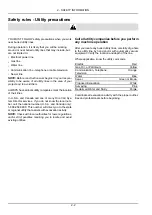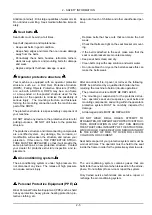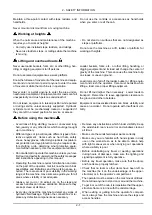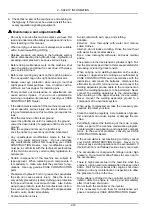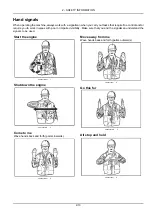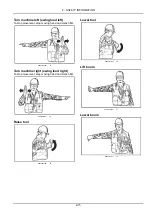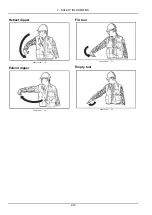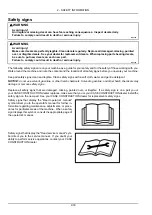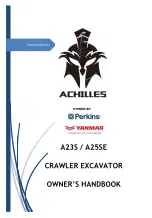
2 - SAFETY INFORMATION
• The working area of the end attachment that is mounted
may interfere with the machine. Interference may be
caused due to the type of end attachment or installa-
tion of parts such as a cab guard. Always maintain a
safe margin of distance. (Be careful of tool swing or ac-
cidental operations.)
• To access or exit the operator’s compartment, the left-
hand control arm must be in the raised position. Never
forget this basic requirement.
• Never leave the operator's compartment while the en-
gine is running.
• To get in or out of the cab, it is imperative that the up-
perstructure frame is in line with the undercarriage.
• Dust, smoke, or mist can reduce visibility and cause an
accident. Reduce speed or come to a complete halt
until visibility has improved.
• Never jump down from the machine. When you exit
the machine or the upperstructure, always face the ma-
chine and use the steps and access handles.
• In the event of an operating problem or failure, move
the machine to a safe place, lower the attachment to the
ground, shut down the engine, and remove the ignition
key. Locate the problem, report it if necessary, and take
the necessary steps to warn others not to attempt to
operate the machine.
• Before tilting the seat back forward, it is mandatory to
raise the armrests to avoid any accidental operation of
the control levers.
• Never turn the key of the battery master switch to “O”
(Off) position when engine is running. The electrical
systems can be damaged.
• When the engine is stopped, always wait three minutes
minimum before you place the key of the battery master
switch in “O” (Off) position, otherwise the program of
the machine controllers will not exit successfully.
Preventing risks caused by vibrations
The machine's vibration affects the comfort and in some
cases the health and safety of the operator. To reduce
vibration risks to a minimum:
1. Make sure that the machine, the equipment, and the
tool are suitable for the work to be carried out.
2. Make sure that the machine is in good condition and
that servicing intervals are complied with.
3. Check the track tension adjustment and the play in
equipment linkages.
4. Make sure that the operator's seat and adjustment
controls are in good condition and then adjust the seat
to suit the operator's size and weight.
During work:
1. Operate all controls gradually to ensure smooth ma-
chine operation.
2. Modify the machine's operation to suit the working
conditions.
3. During travel, adjust the machine's speed, reducing it
if necessary.
4. Make sure that the machine's operating radius is in
good condition, and free of obstacles and holes.
Quick coupler (optional)
• Never place the control switch in the unlocked position
when the machine is working.
• Each time a bucket is installed on the quick coupler,
close the bucket and raise the attachment so as to be
able to make a visual check that the bucket pin is cor-
rectly engaged in the latching hook.
• The quick coupler modifies the working range of the
machine. In certain attachment positions the tool may
damage the machine. Always leave a safe distance
between the quick coupler and the machine..
• Never carry out load handling using the front or rear
anchoring points used to install the tool on the quick
coupler.
• Never put your hands inside the quick coupler. Never
attempt to adjust or repair the quick coupler if the en-
gine is running.
Parking the machine
When parking the machine, proceed as follows:
1. Position the machine on flat, level ground, away from
soft ground, excavations, or poorly shored cavities.
2. Place the upper-structure and the attachment in line
with the undercarriage, retract the attachment, and dig
the bucket into the ground.
3. Lower the dozer blade (if equipped) until it rests on the
ground.
4. Place the gate lock lever in central position before
leaving the operator’s compartment.
5. Stop the engine and remove the ignition key.
6. Lock the cab door.
7. Make sure that the hoods and doors are properly
latched.
2-9
Summary of Contents for CX37C
Page 16: ...1 GENERAL INFORMATION 1 10...
Page 64: ...3 CONTROLS AND INSTRUMENTS Footrest SMIL16MEX1264BA 17 3 12...
Page 136: ...5 TRANSPORT OPERATIONS 5 8...
Page 200: ...6 MAINTENANCE 6 64...
Page 204: ...7 TROUBLESHOOTING 7 4...
Page 212: ...8 SPECIFICATIONS 8 8...








